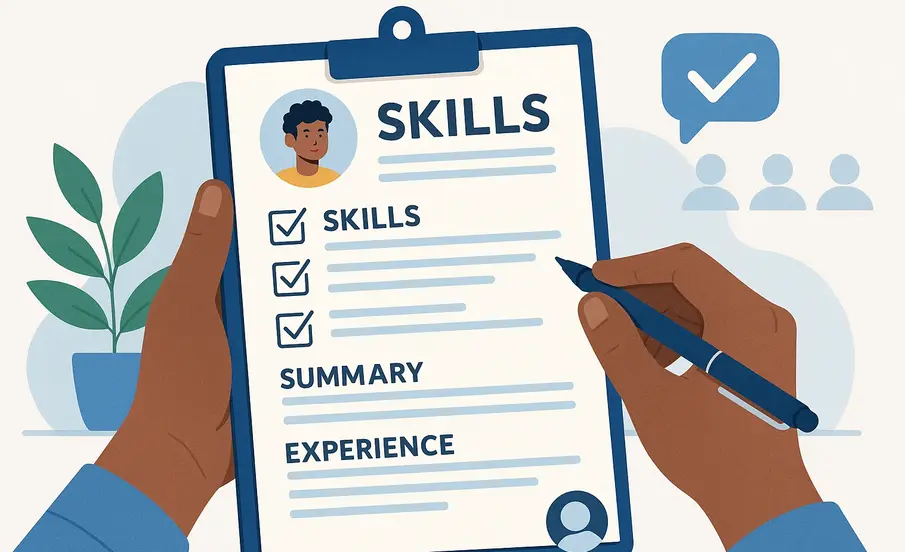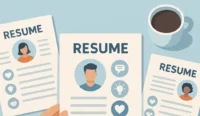In an era defined by rapid technological change, evolving business models, and shifting workforce expectations, recruiters and hiring managers no longer just seek a linear career progression—they’re hunting for demonstrable capabilities and a proven ability to learn on the fly. A skills-first resume flips the traditional chronology on its head, front-loading the competencies that matter most to your target role. By leading with a clear, quantified presentation of what you can do—and how you’ve applied those talents—you immediately signal value to both Applicant Tracking Systems (ATS) and human eyes.
This guide will walk you, step by step, through the process of:
- Identifying the exact blend of technical, analytical, and soft skills you bring to the table.
- Structuring your resume so that these skills are impossible to miss.
- Demonstrating your impact through quantified achievements rather than generic chores.
- Optimizing formatting for seamless ATS parsing and rapid recruiter skimming.
- Iterating and tailoring your document for each new opportunity.
Whether you’re a seasoned professional looking to pivot industries, a recent grad keen to break into tech, or a mid-career specialist aiming for leadership, this approach ensures your resume isn’t just seen—it compels action.
1. The Rise of Skills-First Hiring
Why the Shift?
- Data-Driven Recruiting
- Modern talent teams use analytics to flag top resumes. LinkedIn reports that 69% of talent professionals rank specific skill matches above tenure or alma mater.
- ATS platforms scan for keyword density and contextual relevance; resumes lacking clear skill markers often get filtered out before human review.
- Modern talent teams use analytics to flag top resumes. LinkedIn reports that 69% of talent professionals rank specific skill matches above tenure or alma mater.
- Rapid Market Evolution
- Disruption through automation, AI, and globalization means roles change faster than ever. Employers want “skill agility”—proof you can pick up new tools quickly.
- As industries evolve, experience from even 3–5 years ago may no longer correlate directly to current needs; up-to-date skills carry extra weight.
- Disruption through automation, AI, and globalization means roles change faster than ever. Employers want “skill agility”—proof you can pick up new tools quickly.
- Hybrid and Remote Models
- Distributed teams rely on self-sufficiency and clear deliverables. Resumes that demonstrate remote-work competencies—virtual collaboration tools, digital project management—stand apart.
- Soft skills like communication, cross-cultural awareness, and digital facilitation now compete with coding languages on the shortlist of “must-haves.”
- Distributed teams rely on self-sufficiency and clear deliverables. Resumes that demonstrate remote-work competencies—virtual collaboration tools, digital project management—stand apart.
What This Means for You
A skills-first resume positions you as an adaptable, future-ready candidate. Rather than expecting recruiters to infer your capabilities from job titles and bullet lists, you explicitly showcase your most marketable proficiencies up front—shortening the path from “application” to “interview.”
2. Identifying Your Core Skills
A compelling skills summary begins with rigorous self-audit. Follow these steps:
A. Mine Job Descriptions
- Gather Data: Collect 8–12 job postings for roles you covet.
- Highlight Recurrent Terms: Circle hard skills (e.g., “JavaScript,” “UX research,” “financial modeling”) and soft skills (“stakeholder communication,” “problem solving,” “influence”).
- Cluster by Frequency: Note which skills appear across 60%+ of postings—these are your must-have keywords.
B. Audit Your Track Record
- Role Reflection: For each past position, jot down every tool, methodology, or soft skill you actively used.
- Side Projects & Learning: Include freelance gigs, volunteer work, workshops, and certifications—even brief hackathons or MOOCs count.
- Passion Projects: Personal initiatives (e.g., building a website for a non-profit) often demonstrate transferable skills like self-starting and end-to-end delivery.
C. Rank for Relevance and Mastery
- Relevance Score: Rate each skill 1–5 against your target role’s requirements.
- Proficiency Level: Assign yourself ratings (Beginner, Intermediate, Advanced, Expert).
- Select Your Top 10–14: Aim for a balanced mix—4–6 technical, 4–6 analytical, and 2–4 soft/leadership skills.
By grounding your selections in actual market demand and authentic personal experience, you avoid both keyword stuffing and underwhelming generalities.
3. Structuring Your Resume for Maximum Impact
A clear, logical layout ensures your skills shine. Here’s a high-impact template:
- Header
- Name, current title (optional), email, phone, LinkedIn/portfolio URL.
- Name, current title (optional), email, phone, LinkedIn/portfolio URL.
- Core Competencies
- Single-line title (e.g., “Core Competencies” or “Professional Skillset”).
- 10–14 skills arranged visually (two columns, or a horizontal bar).
- Single-line title (e.g., “Core Competencies” or “Professional Skillset”).
- Professional Experience
- Role title | Company name | Month/Year–Month/Year
- 3–5 bullet points per job, each emphasizing a skill + quantified result.
- Role title | Company name | Month/Year–Month/Year
- Certifications & Education
- Place high-value, role-relevant certifications immediately after skills (e.g., “AWS Certified Solutions Architect – Associate, 2024”).
- Formal education: Degree, institution, graduation year (omit if >10 years old).
- Place high-value, role-relevant certifications immediately after skills (e.g., “AWS Certified Solutions Architect – Associate, 2024”).
- Optional Sections
- Projects, Publications, Volunteer Work (only if they reinforce critical skills).
Layout Tips:
- Stick to 1-page if under 10 years’ experience; 2 pages max otherwise.
- Use 0.5–1 inch margins, sans-serif fonts at 10–12 pt.
- Keep section headers consistent (all caps or bold, uniform size).

4. Crafting a Compelling Skills Summary Section
This section should be impossible to overlook:
A. Category Grouping
Group skills into 3–4 logical buckets, for example:
| Technical Skills | Leadership & Strategy | Data & Analysis | Collaboration & Communication |
| Python • JavaScript • SQL | Agile Project Management | Tableau • Statistical Modeling | Stakeholder Engagement |
| AWS • Docker • Kubernetes | Change Management | A/B Testing • Forecasting | Conflict Resolution |
B. Formatting Options
Two-Column Bullets
Python • Agile Project Management
JavaScript • Cross-Functional Leadership
SQL • Strategic Planning
C. Label Clarity
- Use “Technical Skills” instead of vague “Skills.”
- Avoid mixing scales (e.g., “Advanced” next to “Beginner”).
D. Keyword Alignment
- Mirror phrasing from your target job descriptions verbatim.
- If the JD says “Google Tag Manager,” don’t abbreviate to “GTM”—use the full term.
Why It Works:
Recruiters scanning quickly see a targeted snapshot of your toolbox; ATS algorithms give heavier weight to skills appearing near the top of the document.
5. Demonstrating Skills in Professional Experience
Transition from “I was responsible for” to “I delivered via [skill].” Use the CAR (Context, Action, Result) or STAR format within each bullet:
Example Transformation
- Before:
- Managed social media accounts and email campaigns.
- Managed social media accounts and email campaigns.
- After:
- Action/Skill: Orchestrated integrated email (Mailchimp) and social media (LinkedIn & Instagram) campaigns—
- Context: targeting mid-market B2B audiences—
- Result: boosting MQL volume by 38% and decreasing CPL by 22%.
- Action/Skill: Orchestrated integrated email (Mailchimp) and social media (LinkedIn & Instagram) campaigns—
Bullet Construction Tips
- Lead with Active Verbs: “Engineered,” “Spearheaded,” “Optimized,” “Facilitated.”
- Embed the Skill:
- “(Python) Automated data extraction pipelines, reducing processing time by 60%.”
- Or: “Automated data extraction pipelines using Python…”
- “(Python) Automated data extraction pipelines, reducing processing time by 60%.”
- Quantify Everything:
- Use percentages, dollar impacts, time saved, customer ratings.
- Use percentages, dollar impacts, time saved, customer ratings.
- Group Related Achievements:
- If you led multiple improvements in one role, cluster under one overarching bullet with semicolons.
- If you led multiple improvements in one role, cluster under one overarching bullet with semicolons.
Special Cases
- Early Career / Internships: Emphasize learning curve and outcomes—e.g., “Within 3 months, mastered Google Analytics to identify top-performing channels, increasing referral traffic by 15%.”
- Gaps or Transitions: Use a brief “Skill Development” project entry to bridge gaps—e.g., “Self-directed study of React and Node.js, built two full-stack apps to reinforce proficiency.”
This approach ensures every line in your experience section doubles as proof of a core competency.
6. Showcasing Transferable & Soft Skills
While technical chops get you through the door, soft skills win the buy-in:
A. Embed in Context
- “Facilitated cross-departmental sprint planning sessions (Facilitation & Collaboration), resulting in a 25% reduction in inter-team blockers.”
B. Use Project Spotlights
Create a mini “Featured Projects” section under Experience for 1–2 high-impact initiatives:
Digital Transformation Lead
- Challenge: Company lacked automated billing workflows.
- Solution: Designed and implemented an end-to-end process using Zapier and Salesforce integrations.
- Skills: Process Mapping • Stakeholder Negotiation • Agile Coaching
- Outcome: Reduced invoicing errors by 90% and invoice cycle time by 55%.
C. Testimonials & Awards
- If space allows, insert a brief call-out (in italics) from performance reviews:
“Jane’s conflict-resolution workshops were pivotal in streamlining our vendor negotiations.”
Quantifying soft skills demonstrates that they translate into hard ROI.
7. Strategic Placement of Education & Certifications
Even in a skills-first layout, credentials still matter:
Certifications
- High-Value First: Put role-critical certifications immediately after Skills Summary.
Format:
AWS Certified Solutions Architect – Associate (2024)
PMP (Project Management Professional) – PMI (2023)
Education
Concise Entry:
B.Sc. in Computer Science, XYZ University (2014–2018)
Recent Grads: Add 2–3 bullet points on capstone projects or relevant coursework (e.g., “Machine Learning Algorithms,” “Database Design”).
Ongoing Learning
If you’re actively upskilling, include a “Professional Development” sub-line:
Coursera: Advanced SQL for Data Scientists (ongoing)
- By placing certifications and continuous-learning entries prominently, you reinforce that your skillset is both validated and up-to-date.

8. Optimizing for ATS and Recruiter Scans
Slick formatting for humans must also pass machine muster:
1. Keyword Strategy
- Exact Matches: Mirror phrasing from JDs (e.g., “Content Management Systems,” not “CMS”).
- Semantic Variety: Include synonyms if they appear in separate JDs (e.g., “Stakeholder Engagement” and “Client Relationship Management”).
2. Formatting Hygiene
- No Graphics or Tables: ATS often misread them.
- Standard Fonts: Calibri, Arial, or Times New Roman at 10–12 pt.
- Section Headers: Simple (“Experience,” “Skills,” “Education”), all formatted the same way.
3. File Type & Naming
- PDF Preferred: Keeps layout intact. Some systems require DOCX—check the application instructions.
- Filename: Firstname_Lastname_Resume.pdf—avoid spaces or special characters.
4. Readability for Recruiters
- White Space: At least 1.15 line spacing, 0.5–1 inch margins.
- Bullet Style: Round or square—stay consistent.
- Contact Info: Use a simple header; avoid embedding in a graphic.
This dual-optimization ensures your resume sails through both automated filters and human quick-reads.
9. Design Principles for a Modern Resume
Aesthetics reinforce professionalism:
A. White Space & Margins
- Generous breathing room around headings and between sections.
B. Accent Color
- One muted shade (e.g., navy, charcoal, dark teal) for section headers or skill bullets.
- Tip: Ensure 4.5:1 contrast ratio for accessibility.
C. Layout Variations
- Single vs. Two-Column: Two columns work well for separating Skills/Certifications from Experience/Education.
- Sidebar Styles: Place your Skills summary, certifications, and contact info in a left-hand sidebar to free up space for Experience.
D. Icons & Dividers
- Small, vector-based icons for section headers can add polish—only if ATS-safe.
- Subtle horizontal rules can delineate sections without clutter.
Keep It Simple: Design should accentuate content, never overpower it.
10. Customization, Iteration & Continuous Improvement
A resume is never “done.” Treat it as a dynamic asset:
A. Tailor for Each Role
- Top 3–5 Skills: Reorder to match the highest priorities in each JD.
- Bullet Swap: Swap in most relevant achievement bullets per application.
B. Leverage Data & Feedback
- ATS Simulators: Use Jobscan or Resume Worded to get a “match rate” and optimize keywords.
- Peer Review: Share with mentors or industry contacts for clarity and impact feedback.
C. Track Outcomes
- Maintain a simple spreadsheet logging:
| Job Title | Match Rate (%) | Interviews Secured | Notes |
| UX Designer | 85 | 3 | Emphasize research |
| Data Analyst | 78 | 1 | Add SQL projects |
- Refine: If match rates are low, add or rephrase skills; if interviews aren’t converting, bolster results statements.
D. Keep Up-to-Date
- Quarterly Audit: Add new certifications, side-projects, and metrics.
- Archive Old Roles: Remove positions or details that no longer align with your evolving career focus.
By continuously measuring and iterating, you ensure your resume remains as competitive as you are.
Conclusion
Switching to a skills-first resume transforms you from a passive applicant into an assertive value claimant. You make it effortless for both algorithms and hiring professionals to see, at a glance, the unique blend of technical know-how, strategic thinking, and collaborative prowess you offer. More than a document, it becomes a living portfolio of your capabilities—one you refine, personalize, and adapt as your career evolves.
Start today by auditing your skillset, restructuring your layout, and quantifying your achievements. With each tailored submission, you’ll shorten the path to meaningful interviews and, ultimately, to the roles that truly leverage your strengths. Your next career milestone awaits—make sure your resume paves the way.
Frequently Asked Questions
How many skills should I list?
Aim for 10–14—enough to showcase breadth and depth without overwhelming the reader.
Should I still include employment dates?
Yes—list month and year, but minimize emphasis so skills and outcomes dominate.
Can I use a colored template from Canva?
Yes, if it’s ATS-friendly: simple layout, one accent color, and no embedded images or tables.
What if I’m changing careers entirely?
Lead with transferable skills and project work. Create a “Relevant Projects” section to demonstrate direct applicability.
How do I quantify soft skills?
Tie them to outcomes: e.g., “Facilitated stakeholder workshops, improving cross-team alignment by 30%.”






